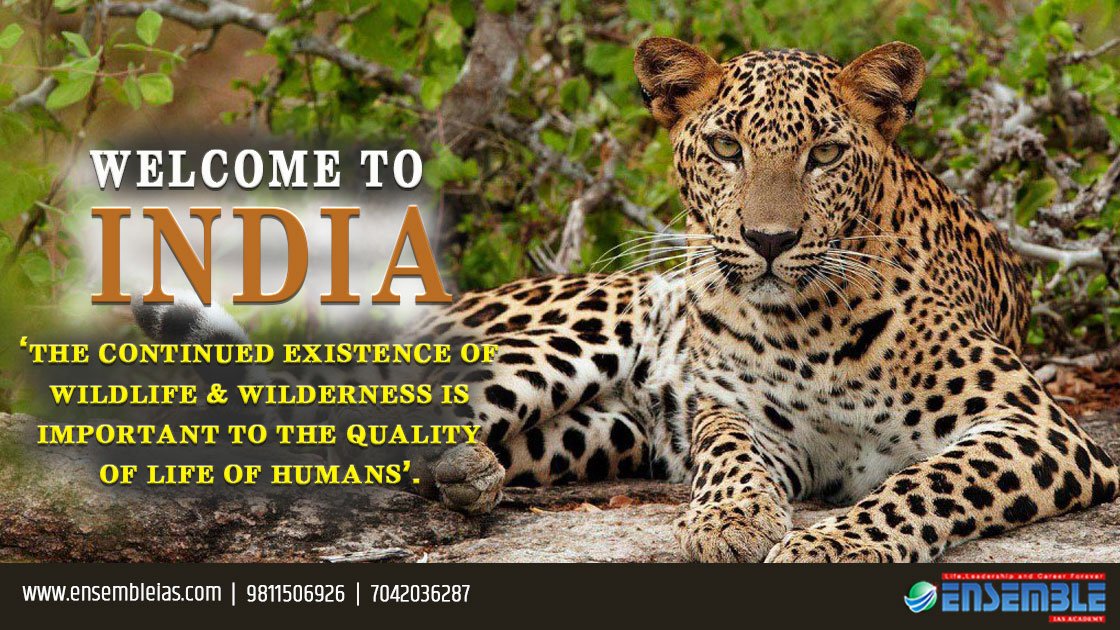WELCOME TO INDIA : ‘The continued existence of wildlife and wilderness is important to the quality of life of humans’.
We don’t own the planet Earth instead we belong to it and in order to survive we must share it with our wildlife. Keeping this in mind the Supreme Court of our country allowed the Central Government of India to introduce the African Cheetah from Namibia in Africa to a suitable habitat in India. The cheetah is the keystone species of the dry forests, scrub forests and the Savannahs. A keystone species is the one which have an extremely high impact on a particular ecosystem relative to its population. It has a disproportionately large effect on its natural environment. The cheetah was declared officially extinct in India in the year 1952. The cause of its extinction was human wildlife conflict, loss of habitat, loss of prey and illegal trafficking. The advent of climate change and an extremely fast-growing population made its survival even worse. According to International Union for Conservation of Nature and Natural Resources (IUCN), the cheetah can be of two types- Asiatic cheetah and African cheetah. The Asiatic cheetah is critically endangered that is it survives only in Iran whereas the African cheetah is vulnerable as per the IUCN.
WORK DONE BY INDIA
 The cheetah is a part of our county’s culture and history. The animal that gets its name from the Sanskrit word ‘chitkara’ which means ‘the spotted one’ once roamed in vast swaths of land in India in the Terai belt in the north to as far as south in Karnataka. The last was shot by the Maharaja Surguja in 1948, though the last sighting of a female cheetah was in 1951. The first plan to bolster the nearly extinct cheetah population in India first floated in 2009 when Iran refused to share the sub- species of the Asiatic cheetah with India it forced the government to look for African ones. In 2010 a panel was set up by the government for reintroducing cheetahs in India. According to the panel, Kuno Palpur (Madhya Pradesh), Velavadar National Park (Gujarat) and Tal Chapar Sanctuary (Rajasthan) were the recommended sites for reintroducing cheetahs. A plan was stalled in the Supreme court of India in the year 2012 to initiate African cheetahs in the Kuno Palpur sanctuary.
The cheetah is a part of our county’s culture and history. The animal that gets its name from the Sanskrit word ‘chitkara’ which means ‘the spotted one’ once roamed in vast swaths of land in India in the Terai belt in the north to as far as south in Karnataka. The last was shot by the Maharaja Surguja in 1948, though the last sighting of a female cheetah was in 1951. The first plan to bolster the nearly extinct cheetah population in India first floated in 2009 when Iran refused to share the sub- species of the Asiatic cheetah with India it forced the government to look for African ones. In 2010 a panel was set up by the government for reintroducing cheetahs in India. According to the panel, Kuno Palpur (Madhya Pradesh), Velavadar National Park (Gujarat) and Tal Chapar Sanctuary (Rajasthan) were the recommended sites for reintroducing cheetahs. A plan was stalled in the Supreme court of India in the year 2012 to initiate African cheetahs in the Kuno Palpur sanctuary.
This was because of various factors that are
- Cheetah project may come in conflict with the parallel project to reintroduce the lions into the same sanctuary and the priority was given to the preservation of our own species.
- It was a matter of concern that whether the cheetah would find the sanctuary favourable for the abundance of prey or not.
- And whether the man animal conflict would be there or not.
In the year 2017 the cheetah plan was revived by the central government. The Supreme Government has set up a three member committee. Decision for the relocation of the African cheetah will be taken after a proper survey.
ARGUMENTS AGAINST THE INRODUCTION
- Threat to endangered species- the nearly extinct Great Indian Bustard is a potential prey for the cheetah and the reintroduction of cheetah may deny the habitat recovery of the bird.
- Competition with other keystone species- the introduction of the cheetahs in Madhya Pradesh would lead them to compete with the wolves which are already the keystone species found in Nauradehi in the state.
- Unsuitable habitat- the cheetahs have to come to Africa where the Serengeti National Park in Tanzania has an area of 14,750 square kilometres with prey base and the Kruger National Park in South Africa is spread across 19,458 square kilometres. While in India the wildlife habitats do not have an area more than a 1000 square kilometres and a much less prey base than African homes of cheetah.
CONCLUSION
The cheetah’s extinction is an emotive issue for India. It has gone solely because if the hunting by humans. According to the environment minister Jairam Ramesh the cheetah needs to be remembered as it represents India’s great culture. The minister himself has played a very crucial role in the reintroduction of cheetahs. Even though the bringing back of cheetah didn’t work in the past it has always been on the wildlife conservation projects. Thus we can look forward for the bringing back of cheetah in our country enhancing its heritage.
AUTHOR- VIDUSHE PANDAY Category:- Environment and Ecology
For more details : Ensemble IAS Academy Call Us : +91 98115 06926, +91 7042036287
Email: ensembleias@gmail.com Visit us:- https://ensembleias.com/
#Cheetah #wildlife #Nature #extremely_endangered #save_dholes #protect_wildlife #stop_deforestation #blog #geography_optional #upsc2020 #ias #k_siddharthasir #Government_of_India #india #studyabroad #geography #upsc #bhugol #government #news #dailynews #gk #dailyquiz #editorial
